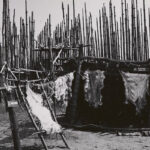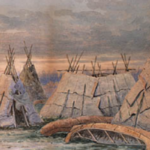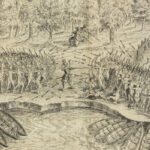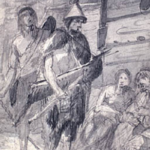Peguis First Nation: A Legacy of Leadership, Resilience, and Renewal
The Peguis First Nation, part of the Anishinaabe (Ojibwe) people, is one of Manitoba’s most significant Indigenous communities. Named after Chief Peguis, a renowned leader who guided his people through times of immense change, the Peguis First Nation has a rich history of cultural resilience and diplomacy. From their early migration to Manitoba to their role in treaty negotiations and modern efforts in cultural revitalization and self-determination, the Peguis First Nation’s story is one of perseverance and pride.
Ancient Origins: Anishinaabe Roots and Migration
The Peguis First Nation’s roots trace back to the Anishinaabe (Ojibwe) peoples, who originally lived in the eastern woodlands around the Great Lakes. Following the Midewiwin prophecy, which foretold a westward migration to a place where food grows on water (wild rice), the Anishinaabe moved westward over centuries, reaching the prairies of present-day Manitoba in the late 18th century.
The Anishinaabe thrived along the waterways of the prairies, leveraging their knowledge of the land and its resources. They established themselves as expert hunters, fishers, and traders, while maintaining a spiritual connection to the land. Their language, Anishinaabemowin, reflects this connection, with specific terms and stories tied to the natural world.
Historian Jean Barman, in West Beyond the West, notes, “The Anishinaabe migration to Manitoba was not just a physical journey but a spiritual and cultural evolution, rooted in their deep respect for the land.”
Leadership of Chief Peguis
Chief Peguis, for whom the First Nation is named, was born in 1774 near Sault Ste. Marie, Ontario. As a young man, he led his people westward to the Red River Valley in present-day Manitoba. By the early 19th century, he had established himself as a key leader, guiding his people in adapting to the challenges posed by European settlement.
Chief Peguis is best known for his diplomatic efforts with the Selkirk settlers, who arrived in 1812 to establish the Red River Colony. Peguis and his people provided vital assistance to the settlers, teaching them survival skills, sharing food, and helping them navigate the harsh winters. This act of generosity cemented Peguis’s reputation as a leader committed to fostering peaceful relations.
Historian Sarah Carter, in Lost Harvests: Prairie Indian Reserve Farmers and Government Policy, writes, “Chief Peguis’s leadership during the early 19th century exemplified the spirit of diplomacy and generosity that defined Anishinaabe governance.”
Governance and Social Structure
The Peguis First Nation traditionally followed Anishinaabe governance systems based on consensus and collective responsibility. Chiefs and leaders were chosen for their ability to guide with wisdom and fairness, while elders provided counsel rooted in oral history and spiritual teachings. The Anishinaabe placed a strong emphasis on harmony within the community and respect for the natural world.
Ceremonial gatherings, such as seasonal feasts and the Midewiwin Lodge ceremonies, reinforced cultural identity and spiritual connection. These practices provided a sense of unity and continuity, even during times of upheaval.
First Contact and the Arrival of the Selkirk Settlers
The Peguis people’s first sustained contact with Europeans occurred in the late 18th century, as fur traders from the Hudson’s Bay Company and North West Company established trading posts in the Red River Valley. The Anishinaabe became integral to the fur trade, exchanging furs and provisions for European goods such as firearms, metal tools, and textiles.
The arrival of the Selkirk settlers in 1812 marked a turning point in the region’s history. The settlers, largely Scottish immigrants, faced significant challenges in adapting to the harsh prairie environment. Chief Peguis and his people provided crucial assistance, helping the settlers establish their colony. Despite this cooperation, tensions arose as settlers encroached on traditional lands and disrupted Indigenous ways of life.
Anthropologist Bruce Trigger, in Indigenous Peoples of Canada, observes, “The arrival of settlers in the Red River Valley introduced profound changes, creating both opportunities for collaboration and challenges for the preservation of Indigenous traditions.”
Treaty 1 and the Peguis Reserve
The signing of Treaty 1 in 1871 marked a pivotal moment in the history of the Peguis First Nation. Chief Peguis’s descendants, along with other Indigenous leaders, negotiated the treaty to protect their traditional livelihoods while adapting to the pressures of settler expansion. Treaty 1 promised land, education, and healthcare, as well as the protection of hunting and fishing rights.
However, the implementation of the treaty was fraught with challenges. In 1907, the Peguis people were forcibly relocated from their original reserve near the Red River to their current location near Fisher River, about 190 kilometers north of Winnipeg. This displacement severed their connection to traditional lands and imposed significant hardships.
Historian Margaret Conrad, in A Concise History of Canada, notes, “The relocation of the Peguis people reflects the broader pattern of systemic marginalization and land dispossession faced by Indigenous nations in Canada.”
Resilience Through Colonization
Despite the profound disruptions caused by displacement, residential schools, and restrictive colonial policies, the Peguis First Nation maintained their cultural identity and traditions. Ceremonies such as the Sun Dance, storytelling, and traditional crafts continued to be practiced, often in defiance of colonial regulations.
The residential school system, which aimed to assimilate Indigenous children, had a devastating impact on the community. Generations of Peguis children were removed from their families, prohibited from speaking their language, and subjected to harsh conditions. The long-term effects of these schools are still felt today, but the Peguis First Nation has been at the forefront of healing and reconciliation efforts.
Modern Resurgence and Advocacy
In recent decades, the Peguis First Nation has emerged as a leader in cultural revitalization, economic development, and treaty rights advocacy. Efforts to preserve Anishinaabemowin and restore traditional ceremonies have been central to their resurgence. Educational programs, cultural workshops, and youth mentorship initiatives ensure that future generations remain connected to their heritage.
The Peguis First Nation has also been involved in landmark legal cases to assert their treaty rights. In 2008, they successfully negotiated a $126 million settlement with the federal government for the wrongful surrender of their original reserve lands in 1907. This settlement was a significant victory, highlighting the community’s determination to seek justice.
Chief Glenn Hudson, a prominent leader of the Peguis First Nation, stated in a 2018 interview with CBC News, “Our people have endured great hardships, but we remain strong. Our ancestors’ sacrifices guide us as we work to build a brighter future.”
Environmental Stewardship
The Peguis First Nation has long been a steward of the waterways and forests of their territory. Traditional ecological knowledge informs their practices in hunting, fishing, and land management. In recent years, the community has taken a leading role in advocating for the protection of water resources and combating climate change.
In The Resettlement of British Columbia, historian Cole Harris writes, “The Peguis people’s approach to environmental stewardship reflects their deep understanding of the interconnectedness of cultural and ecological health.”
Peguis First Nation Today
Today, the Peguis First Nation is Manitoba’s largest First Nation community, with over 10,000 members. Their thriving community blends traditional practices with modern governance and economic innovation. Initiatives in renewable energy, housing, and education reflect their commitment to self-determination and sustainability.
Annual events, such as the Peguis Treaty Days, celebrate the nation’s heritage and provide opportunities for members and visitors to engage with Anishinaabe traditions. Partnerships with universities, governments, and businesses highlight their leadership in advancing reconciliation and nation-building.
A Legacy of Strength and Renewal
The history of the Peguis First Nation is a testament to their resilience, adaptability, and deep connection to the land. From their early migration to Manitoba to their leadership in treaty advocacy and cultural revitalization, the Peguis people have preserved their identity and place within Canada’s evolving landscape.
As Chief Glenn Hudson stated, “The Peguis story is one of resilience, pride, and a commitment to honouring our ancestors while shaping a brighter future for our children.”
References
- Barman, Jean. West Beyond the West: A History of British Columbia. University of Toronto Press, 1996.
- Carter, Sarah. Lost Harvests: Prairie Indian Reserve Farmers and Government Policy. McGill-Queen’s University Press, 1990.
- Conrad, Margaret. A Concise History of Canada. Cambridge University Press, 2012.
- Fisher, Robin. Contact and Conflict: Indian-European Relations in British Columbia. UBC Press, 1997.
- Ignace, Marianne and Ronald E. Ignace. Keeping the Stories Alive: Language, Land, and Culture in Indigenous Communities. University of Toronto Press, 2008.
- Harris, Cole. The Resettlement of British Columbia: Essays on Colonialism and Geographical Change. UBC Press, 1997.
- Hudson, Glenn. “Reclaiming Our Legacy: The Future of Peguis.” CBC News, 2018.
- Treaty 1 Elders. Voices of the Plains: Stories from Treaty 1 Communities. University of Manitoba Press, 2005.
- Peguis First Nation. Guardians of the Waterways: The History and Culture of Peguis First Nation. Peguis Publications, 2015.
- Trigger, Bruce G. Indigenous Peoples of Canada. McGill-Queen’s University Press, 1992.



